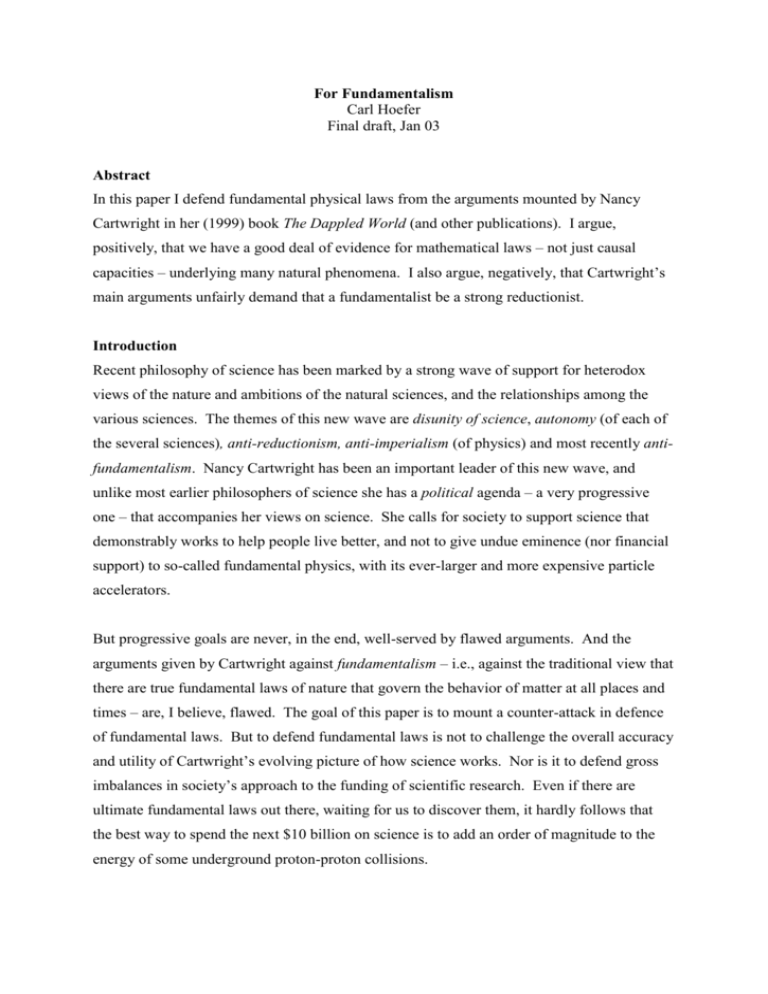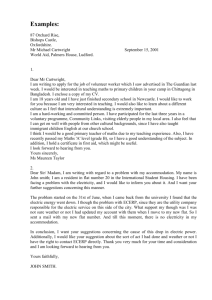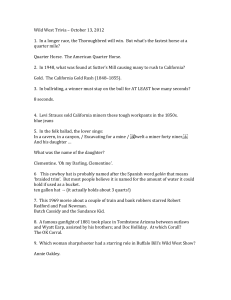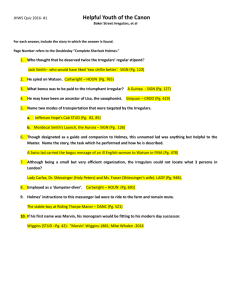- PhilSci
advertisement

For Fundamentalism Carl Hoefer Final draft, Jan 03 Abstract In this paper I defend fundamental physical laws from the arguments mounted by Nancy Cartwright in her (1999) book The Dappled World (and other publications). I argue, positively, that we have a good deal of evidence for mathematical laws – not just causal capacities – underlying many natural phenomena. I also argue, negatively, that Cartwright’s main arguments unfairly demand that a fundamentalist be a strong reductionist. Introduction Recent philosophy of science has been marked by a strong wave of support for heterodox views of the nature and ambitions of the natural sciences, and the relationships among the various sciences. The themes of this new wave are disunity of science, autonomy (of each of the several sciences), anti-reductionism, anti-imperialism (of physics) and most recently antifundamentalism. Nancy Cartwright has been an important leader of this new wave, and unlike most earlier philosophers of science she has a political agenda – a very progressive one – that accompanies her views on science. She calls for society to support science that demonstrably works to help people live better, and not to give undue eminence (nor financial support) to so-called fundamental physics, with its ever-larger and more expensive particle accelerators. But progressive goals are never, in the end, well-served by flawed arguments. And the arguments given by Cartwright against fundamentalism – i.e., against the traditional view that there are true fundamental laws of nature that govern the behavior of matter at all places and times – are, I believe, flawed. The goal of this paper is to mount a counter-attack in defence of fundamental laws. But to defend fundamental laws is not to challenge the overall accuracy and utility of Cartwright’s evolving picture of how science works. Nor is it to defend gross imbalances in society’s approach to the funding of scientific research. Even if there are ultimate fundamental laws out there, waiting for us to discover them, it hardly follows that the best way to spend the next $10 billion on science is to add an order of magnitude to the energy of some underground proton-proton collisions. But, along with gargantuan particle accelerators, Cartwright’s arguments put in a bad light a different, much less expensive endeavour: [much of] current philosophy of physics. This paper aims to help justify the practice, common among philosophers of physics, of taking for granted that there are fundamental physical laws. What is Fundamentalism? A fundamentalist believes in something rather ultimate and mysterious; not God, of course, but something that nevertheless “governs” the whole universe, from top to bottom. What she believes in is the fundamental law(s) of nature. These are what physics has been seeking, and getting closer and closer to actually grasping, since the time of Descartes. They are truths, expressable in mathematical language, that accurately describe the behavior of all things in the physical world, at all times and places. This view has been standard among physicists, and most philosophers of science, for at least a hundred years. There are a number of questions about fundamental laws that do not matter for this essay. For example: do they have some kind of physical necessity, or are they rather mere Humean regular associations? Would fundamental laws (if they existed) explain everything – or nothing? Do the laws need to be explained, themselves, to have explanatory power? Do all causal or other non-fundamental laws need to be derivable somehow from fundamental laws, in order to be real? None of these issues is pertinent to Cartwright’s attack, nor to my defence. Why I am a Fundamentalist Fundamentalism only makes sense in the context of certain other philosophical assumptions – widespread ones, to be sure, but not universal. One has to believe in an external physical world, and that we have at least some non-trivial epistemic access to it. One has to believe that it would be nice to have explanations for the widespread and reliable regularities that we observe in the world; and that true universal laws, if there were any, could play at least some part in providing such explanations. Given these minimal starting assumptions, a fundamentalist believes that the recent history and current state of knowledge in physics provides strong and variegated evidence that there are indeed universal fundamental laws with which all physical phenomena are in accord. Later we will look at, and try to answer, Cartwright’s arguments for the weakness of this evidence and implausibility of the fundamentalist’s picture. But here it will be helpful to note that Cartwright is ready to offer an explanation of some of the remarkably precise (and often useful) regularities in nature that physics has been able to disclose. She favors an explanation that invokes stable causal capacities in nature, and a “patchwork of laws” neither universal nor fundamental. By contrast, some philosophers – perhaps e.g. van Fraassen – would deny that we can or should seek any explanations of nature’s regularity. I will not try to defend fundamentalism against these more seriously sceptical views here. Why, then, do I think that physics today gives strong evidence for the existence of true, universal and fundamental laws? Before getting down to cases, let me note that by “laws”, throughout, I will mean usually mathematical equations, and never so-called “causal laws”. Sometimes a fundamental law may take the form of a prohibition or non-existence claim (e.g. the Pauli exclusion principle), but most of the time they take the form of mathematical equations relating one or more functions to each other, or to a constant such as zero. The equations, as Russell (1912) pointed out, are often such as to suffer no easy reading in terms of causation. Whether or not Russell was right to claim that causation had been banished from fundamental physics, we can at least assume that the laws we are discussing are not usually best read as mathematized ways of saying “Xs cause Ys”. Nor are they intended to be read with a tacit “ceteris paribus” at the end or beginning. They are universal, exceptionless, precise regularities. My reasons for thinking there must be such things are probably no different from those of most other fundamentalists. We have already found such mathematical regularities that are true or very close to true wherever we are able to check. And their nature is such that we can imagine them being replaced one day by other mathematical laws still more accurate or universal (as has happened before in the history of physics), but not their being superseded by non-mathematical statements of some kind, or given up without any replacement at all. To go any further, we need to start looking at examples. For reasons of brevity, I will look at just one: the Schrödinger equation and atomic structures. With the help of the Schrödinger equation, physicists have been able to calculate quite a lot about the structures of atoms, and how atoms combine to form simple molecules. A lot of this achievement has, on close examination, the look of Cartwright’s image of physics: a motley assortment of models involving idealizations and abstractions of varying degrees of incredibility, chosen in opportunistic ways and often constrained and guided by independent bits of causal knowledge. But not all atomic models have this patchwork character, and in particular the simplest atom – hydrogen – reveals a quite different picture to us. Working through the exact solution of Schrödinger’s equation for the hydrogen atom was an important milestone in my formation as a fundamentalist. I had never before been, and still was not, happy with QM overall as a candidate fundamental theory; at a minimum, such theories should allow a coherent interpretation, and QM falls down badly on that front. Nevertheless, it offers us a well-defined differential equation and at least clearly says: “This mathematical law governs the structure of matter.” When you work through the exact solution of the hydrogen atom, you see that in some very important sense, at least, this claim has to be right. The existence of a stable state, in which the proton and electron are bound to each other spatially yet never collapse as one would classically expect (and as one would also expect based on the ascription of their capacities qua oppositely-charged things) falls out beautifully from the solutions of the equation. More impressively still, perhaps, the energy eigenvalues of the permitted orbitals fall out also, and their differences precisely match the measured emission spectra of hydrogen. And unlike just about every other application of QM and the Schrödinger equation, these calculations can lay claim to being exact rather than approximate, realistic rather than idealized. What is particularly salient about the hydrogen solution is that its achievements transparently flow from the solution of an equation, and from nothing else. You do not arrive at the Leguerre polynomials describing the electron’s orbitals by happenstance or by crafting a model using a mix of intuition, antecedent causal knowledge and so forth. So even though QM is a shambles in many ways and should be replaced as soon as possible by a better theory, if that theory is going to retain QM’s ability to account for the atomic structure of hydrogen, it is going to have to give us a mathematical equation structurally isomorphic to the Schrödinger equation as what governs that structure. From the 1930’s onward, our understanding of hydrogen has been and will be based on a mathematical equation. I can see how we might come to view that equation as non-fundamental but rather derivable from some other mathematical law or laws. But I can’t see how we might come to view the equation as a mere codification of the result of the actions of capacities under highly constrained circumstances. The reason is this: to maintain this stance, we would need to be able to specify what the relevant capacities are, independently, and then show how under such-and-so circumstances their operation makes a certain equation true. For electrons and protons, we can’t do the former (other than in a trivial sense), and hence can’t get anywhere near doing the latter. What are the capacities carried by electrons and protons? I guess we could say: they have (because of the charges they carry) the capacity to attract and repel positively and negatively charged things. We can even quantify this capacity, via Coulomb’s law. But this doesn’t help explain the stable hydrogen atom; on the contrary, it leads us to expect that electrons and protons should in general collide, not form a stable “orbiting” type situation. We could add that electrons and protons have the capacity to form (relatively) stable neutral combinations, called “atoms”, and that sometimes this capacity overrides the attraction/repulsion relationship. But we can only get beyond this triviality and say more, by writing down the Schrödinger equation and calculating its solutions. The explanatory primacy of the law over the capacities-talk here is evident. Above I have discussed just one aspect of modern physics that inclines me toward belief in true, universal fundamental laws. But similar examples could, I believe, be developed from the successes of quantum field theory and General Relativity. Everywhere I look, I seem to see such laws in action, producing the wonderful variegation of the blooming and buzzing confusion in which we live on the basis of a few underlying, perfect regularities. But this should sound suspiciously reminiscent. Fundamentalists of the other sort, i.e. believers in a certain kind of God, often claimed to see evidence of God’s perfection and goodness everywhere they looked. To put it mildly, many of us now incline to a different view on that issue. Perhaps I am deluding myself in just this way about laws of nature. The best way to address this is now to look at Cartwright’s arguments against them. Against fundamentalism Cartwright’s arguments against fundamental laws are many sided, and have evolved in several ways over the course of the 19 years since How the Laws of Physics Lie. It is not possible to do justice to them in a brief sketch, because their full strength depends on the overall plausibility of the competing metaphysics and methodology of science that she develops to replace the fundamentalist’s picture. So the present description will inevitably be somewhat unfair. Hopefully most readers will be familiar with the main arguments already and the remarks below can serve more as reminders than as a fair summary. The main elements of her anti-fundamentalist arguments can be found in (1999) ch. 2, and (2000). Cartwright claims that all the laws in physics ought to be read as ceteris paribus laws: they tell us what happens, as long as nothing from outside the domain of the given law interferes. When factors from the outside do occur, they can mess things up quite easily, and the regularity stated in the physical law fails. “My conclusion from looking at a large number of cases of how theories in physics are used to treat real situations in the world, both in testing the theories and in their impressive technological applications, is that it is always ceteris paribus regularities that come into play. All the cases I have looked at have just the characteristic I point to: they are either especially engineered or especially chosen to include only those causes that occur in the preferred set of the theory. They are, moreover, always arranged in a very special way: a way that the theory knows how to describe and to predict from. That is not surprising where ceteris paribus laws are involved, since we can neither test laws of this kind nor apply them until we are sure the ceteris paribus conditions are satisfied. The point is that these are the kinds of cases that give us our most powerful reasons for accepting our theories in physics. And the laws they give us reason to accept are all ceteris paribus laws.” (2000, p. 210.) When one gets down to specific examples, I see Cartwright’s arguments as falling into two groups. The first I will call the no-forces group; the second, the no-models group. Let’s first look at an example from the former group. Cartwright uses Neurath’s example of a thousand-mark banknote falling in a public square as an example of the failure of Newton’s second law (F = ma). Unlike a compact sphere dropped in a vacuum, whose motions will obey the second law (with the law of gravity supplying the force), the banknote will flutter and fly around quite a bit, eventually coming to rest far from where it was dropped. Does this falsify second law? Of course not, says the fundamentalist: the bill’s deviation from a free-fall trajectory is explained by other forces on it (the wind and air resistance). But where, asks Cartwright, in physics does one get the wind forces from? The answer is: nowhere, because physics tells us practically nothing about wind or how it affects floppy paper objects. To hold that the second law is true in this case, you have to assume on faith that if one back-calculates the forces necessary to produce the motions of the bill correctly, assuming the second law and subtracting the force of gravity, then (a) the forces you calculate really did exist, on the bill, as it fluttered around; and (b) those forces are in principle derivable from other fundamental physical laws (QM, perhaps). This is an awfully big thing to take on faith, Cartwright thinks. It’s much better to simply allow that the banknote’s fall doesn’t fall under the second law, because that law’s ceteris paribus clause is clearly not satisfied. In order to justifiably assert that the second law does apply here, we need more than fundamentalist faith; we need a good model, derived in a nonad hoc manner from the relevant other areas of physics. For the banknote, we don’t have one, nor much reason to think we ever can have one. The no-forces sort of objection thus naturally brings us to the no-models objections. Cartwright doesn’t exactly demand that a defender of fundamentalism should be able to come up with a good physical model of something like our banknote fluttering, or a cheesecake baking. But if we are to have faith in fundamental laws, at least the theories presenting those laws ought to tell us, in a principled way, how one goes about constructing such a model. But this is what our fundamental theories fail to do. Instead, they typically give us a set of interpretive models that demonstrably obey the relevant laws. Wherever we can force nature to fit the mold of one of these interpretive models, there we can say that the theory applies. But the range of the interpretive models, for our actual fundamental theories, is quite poor. This is a claim Cartwright has been able to argue with particular force in the realm of quantum mechanics. The fundamental law, Schrödinger’s equation, can only be applied to something if one knows the right Hamiltonian function to use. But the theory itself does not give rules for how to construct a Hamiltonian for any given system. The theory does say how to translate the classical Hamiltonian for a (presumably) analogous system into a quantum Hamiltonian; but this rule is by no means enough to cover all intended applications of the theory. So what ends up being the case is that a handful of Hamiltonian functions are known, for a handful of well-defined types of physical situation. Where we have reason to think that a system is structurally like one of these models, there we can apply Schrödinger’s equation and hence QM. Where none of the handful of models fits, there – in Cartwright’s view – QM is silent. Something similar might, I think, be said for the case of General Relativity. The upshot of these observations about the limitations of what we can successfully model with our current theories, for Cartwright, is a strong limitation on what we have a right to induce from their successes. “This raises one of the most central questions we face in philosophy of science: what should be the bounds on our inductions? . . . I should like to appeal to a crude intuitive principle: when we can recognize a clear boundary within which all our successful cases have been located and, moreover, we can offer good reasons why that boundary might well be relevant, then failing compelling reason to the contrary, we should not extend our inductions beyond that boundary.” For a large number of theories in physics that I have looked at, I think we have such a clear boundary: the empirical successes of the theory are all for cases that fit the theory’s interpretive models, or better, that fit some arrangement licensed by the theory of its interpretive models.” (2000, p. 215) This takes us to one of the central theses of The Dappled World: we have reason to think that laws are true where reality matches one of the models in which we know the laws hold; but not elsewhere. Laws are true in bits of reality that match our interpretive models – nomological machines – but not outside of those bounds. Answering the arguments. Cartwright (2000) sets the core of the dispute out very clearly: what may we induce, from the successes of our physical theories, including those I described earlier? Her answer seems to boil down to this: you can induce that the theories truly describe those systems that have been shown to fit the core interpretive models of the theories, and nothing more. Notice how dangerously close her answer is to the following: We have reason to think that the laws of a physical theory hold only in those cases where we can show that they hold. But this is not so much a principled restriction on induction, as a flat unwillingness to induce anything at all! Much depends, obviously, on how reasonable and principled the dividing line Cartwright offers really is. A fundamentalist thinks that the range of (approximate) truth of the Schrödinger equation goes quite a bit further than the list of cases where it can be explicitly demonstrated, and that this is a reasonable inductive conclusion to draw from the successes of QM. Clearly, we are faced with competing burden-of-proof arguments. What I want to suggest here is that Cartwright’s arguments saddle the fundamentalist with unreasonable reductionist demands. At this point we need to look at a a distinction, introduced by Cartwright, between two types of physical reduction: crosswise vs downward reduction ((2000), pp. 207 – 8). Downward reduction is the familiar reduction of macroscopic processes to the microscopic particles/events composing them. Cartwright claims not to be saddling the fundamentalist with the burden of providing downward reductions. Instead, she asks for successful demonstration of crosswise reductions, meaning: demonstration that the laws holding inside the laboratory also hold outside of it. The fundamentalist thinks that all of physical nature is governed by some fundamental mathematical law or laws. They are true everywhere and at all times. But obviously, the phenomena these laws allow, which we see all around us, can be of enormous complexity and variety. A fundamentalist thinks that the phenomena studied in chemistry, biology, meteorology etc. all are composed of the doings of atoms, molecules, photons, fields, and so on; and that these constituents are perfectly governed by the fundamental laws. But she need not believe any sort of thesis of the reducibility of biology, chemistry, or meteorology to physics! The lessons we have learned in the past half-century from the failure of various reductionist programmes are many, but they do not include a lesson to the effect that there are no fundamental laws of nature. Yet it seems that in order to answer Cartwright’s objections in the way she desires, the fundamentalist would have to deliver a successful reduction of all the sciences (and much that is not overtly covered by any science) to fundamental physical theories. Suppose we discuss the gasoline-oxygen explosions in my engine’s cylinders. In line with what she says about the banknote, I suppose Cartwright would not want to admit that the Schrödinger equation holds inside the cylinder, without being given an appropriate Hamiltonian for this kind of system, and the calculations to show that an adequate model within the theory is available. But this is to demand either theory-theory or type-type reductionism of a very strong sort – downward reduction. I suspect most fundamentalists have no wish to argue that such a reduction is possible, for us at least. This means, then, that given the way Cartwright draws her principled boundary on inductions, we can never say we have good grounds for believing fundamental laws to hold everywhere unless we can provide the explicit reductions to prove it. We may call these reductions crosswise if we wish, but they will in general have to be downward also. This is, I submit, an unreasonably strong requirement. Cartwright’s principled boundary on inductions does make sense if we start by assuming the correctness of her patchwork ontology of capacities without fundamental laws. But equally, the fundamentalist’s induction of the holding of laws such as the Schrödinger equation outside the laboratory setting makes sense, if we start with the assumption that nature is fundamentally governed by mathematical regularities, with causality being a mere imperfect, anthropomorphic conceptual tool. A world of simple building blocks To end, I want to discuss two final issues: the simplicity argument for believing that laws hold outside our models as well as inside, and the vexed problem that all the fundamentaltype laws we have been able to conceive to date are known to be false, perhaps even badly false (for the kinds of reasons fundamentalists themselves give, not the kind highlighted by Cartwright). The primary argument for fundamentalism, not yet mentioned, is this: we all believe, with very good reason, that things in the physical world are all composed of a few basic types of particles: electrons, protons, neutrons, and photons, mostly, along with a tiny amount of more esoteric particle kinds. We know that these tiny things are puzzling in various ways, and they cannot be thought of as Newtonian-style billiard balls moving on smooth trajectories under the influence of purely local force fields. Nevertheless, they are here to stay. Whatever radical changes future physics may bring, it is not really conceivable that, a lá phlogiston, these entities will vanish without a trace and come to be seen as embarrassing errors with no correlate or counterparts in the True Physics. Moreover we know a good bit about how these things behave, in certain settings. A big part of this knowledge is given by QM and is connected with the Schrödinger equation. Where we are clever enough to be able to test this theory and this equation, they seem to be correct. But – aside from this question of what we are clever enough to be able to model and treat with a theory – there seems to be no very relevant difference between matter inside the labs and matter outside the labs. A hydrogen atom in a spectrometer is, plausibly, much the same as a hydrogen atom floating in your living room. The simplest hypothesis would seem to be that if there are mathematical laws governing these things in one setting, then the same laws govern them everywhere. The sentence in bold above is precisely where Cartwright would say I have gone astray. (Or she might agree with the simplicity claim, but deny that that has any epistemic force.) Her view is that these successful tests show only that certain kinds of systems, that can be modelled in such a way as to let us deploy our well-understood models, obey mathematical laws. They may be outside the laboratory as well as inside, but most of what goes on outside cannot be so modelled. Instead, she proposes, an equally good hypothesis is this: the mathematical laws manage to capture the effects of the operation of real capacities in nature, under certain restricted conditions; we may induce the existence of the same capacities outside the laboratory, but not the truth of the mathematical laws. We are back almost to square one: how can the fundamentalist argue that the tests and successes show more, especially when she (in all likelihood) accepts that QM is not even a fully interpretable theory, much less a part of the True Final Physics? For it has to be acknowledged that the failure of QM to be demonstrably valid everywhere is not merely a matter of calculational complexity and a lack of cleverness on our part. It is also a product of two further factors. The first, stressed by Cartwright, is that QM provides only incomplete model-building prescriptions – in particular, it has no rules for constructing the right Hamiltonian for any arbitrary system. (But note that to have such rules would be, in effect, to have built-in reductions of arbitrary systems to micro-level models.) The second, related reason, is equally important: QM, wonderful though it is, is not The Truth, not a part of the True Final Physics, but only an approximation of some kind to the latter, for certain domains. And the same goes for other theories such as GR or QFT, even though they may be nicer in some ways than QM. I suspect that the Schrödinger equation does “govern”, in the appropriate sense, quite a lot of what goes on outside of labs and superconductors and other well-regimented environments. But as a fundamentalist who is convinced that QM is ultimately a false theory that merely gets close to the truth in certain ways and certain domains, I do not have to argue at length over this question. And here we have arrived at perhaps the most important reason why fundamentalists feel they can resist Cartwright’s patchwork of laws. The ultimate set of mathematical laws that a fundamentalist believes in is meant to be unified, consistent, coherent, and of clear applicability to any real situation. Unlike GR, it should not say patently false things about matter (GR says it is a continuous fluid); unlike QM, it should not use an unprincipled mix of concepts from earlier theories and uninterpretable new mathematical objects. The ultimate laws will be true in supernovae and in teacups, lasers and banknotes. We won’t be able to prove this case-by-case, nor reduce molecular biology or chemistry to fundamental physics: I repeat, no reductionism need be possible. But we should have much better grounds for thinking that our inductions can proceed beyond the bounds of our nomological machines, than we presently do for incomplete and false theories such as GR and QM. It is these laws that the fundamentalist believes in, not the half-way houses we have managed to construct to date. It may seem as though my defence of fundamentalism has in the end collapsed back into an expression of blind faith. Not so. Let me recount the components of the answer to Cartwright’s anti-fundamentalist arguments. ! The simplicity argument is surely onto something relevant and important. A hydrogen atom is a hydrogen atom, whether in an interferometer or a dirigible; if its behavior is governed by mathematical laws in one setting, there is prima facie reason to expect it is so governed in the other. ! One cannot simply insist that inductions should stop at the boundaries of what has already been successfully modelled, for this is tantamount to claiming that fundamentalism can only be vindicated by the demonstrated achievement of a very strong reductionism, much stronger than what any fundamentalist should (or, I suspect, does) currently believe possible. ! If we accept our starting point above, namely that there is a need to explain such widespread and reliable regularities in nature as we have been able to uncover, both in daily life and in science, then we seem to face a choice between the fundamentalist’s picture or Cartwright’s patchwork, capacity-based picture. This brings us back to what I tried to stress in connection with the calculation of the hydrogen atom’s structure. Many of the scientific and technological successes of physics can be adequately described in the language of stable capacities and Aristotelian natures. But quite a lot of it cannot, or can only be done so very awkwardly. This speaks in favor of the idea, widely accepted since the 18th century at least, that the ultimate explanations of nature’s many regularities will be couched in mathematical language, not the language of cause and effect, tendencies and propensities, strivings and so forth. We know from many examples how phenomena at first describable only imprecisely using causal talk can be given a deeper account by bringing them under mathematical laws (examples: reflection and refraction of visible light; attraction and repulsion between charged macro-bodies). We don’t, I think, have good examples that go in the opposite direction. Cartwright’s patchwork of laws and capacities offers us a picture of science and its possibilities that is very faithful to the current state of theory and practice. That is its weakness: it holds out no reason to think that our deepest explanations can get significantly better (though at least our engineering can). The fundamentalists’ view does however aim at significantly deeper and better explanations, at a fundamental level – even though they may not help us with our engineering. To engineers and experimentalists, I commend Cartwright’s philosophy of science wholeheartedly. But I hope to have made space for theoreticians and philosophers of physics to keep their faith in a world with fundamental physical laws. Bibliography Anderson “Review of The Dappled World”. Studies in History and Philosophy of Modern Physics, 2001. Cartwright, N. The Dappled World: A Study of the Boundaries of Science (Cambridge University Press, 1999). Cartwright, N. “Against the Completability of Science”, in The Proper Ambition of Science ed.s M.W.F. Stone and Jonathan Wolff (Routledge, 2000). Feynman, R. The Character of Physical Law (Pauli Lectures, Cornell U., 1964) (BBC, 1965). Russell, B. “On the notion of cause”. in Mysticism and Logic (Allen & Unwin, 1912).





